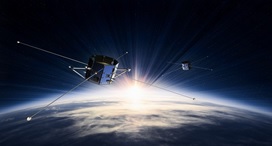22 September, 2025
TRACERS: NASA’s Twin Satellite Mission
Wed 30 Jul, 2025
On a mission to deepen our understanding of how the Sun influences the Earth, NASA recently launched TRACERS – Tandem Reconnection and Cusp Electrodynamics Reconnaissance Satellites. This twin-satellite mission is a groundbreaking step toward investigating a fundamental process in plasma physics known as magnetic reconnection, which directly affects space weather and, in turn, Earth's technological systems.
Magnetic Reconnection?
Magnetic reconnection is a powerful physical process that occurs in plasma, the fourth state of matter made up of charged particles. In this phenomenon, magnetic field lines from different magnetic domains are rearranged and release a tremendous amount of energy.
- It plays a critical role in solar flares, auroras, and geomagnetic storms.
- It is also a key mechanism that allows solar wind (a stream of charged particles from the Sun) to interact with Earth’s magnetosphere.
Why is TRACERS Important?
- Earth is surrounded by a magnetic field known as the magnetosphere, which shields the planet from harmful solar and cosmic radiation.
- However, this shield is not impenetrable. At specific regions called polar cusps, funnel-shaped holes allow solar particles to leak through. TRACERS will fly through these polar cusps in low Earth orbit to study this precise region.
Mission Objectives:
| Focus Area | Details |
| Mission Name | TRACERS (Tandem Reconnection and Cusp Electrodynamics Reconnaissance Satellites) |
| Objective | Study magnetic reconnection in polar cusps |
| Orbit | Low Earth orbit |
| Launch | 2025 (as per latest NASA release) |
| Scientific Goal | Understand the Sun–Earth magnetic interaction |
| Technology Impact | Improve space weather forecasting |
What TRACERS Will Study
1. Solar Wind Dynamics
o TRACERS will measure the flow of solar wind—a constant stream of charged particles from the Sun—and its interaction with the Earth's magnetic field.
2. Cusp Electrodynamics
o By traversing the polar cusp areas, the satellites will observe how energy and particles are transferred from the solar wind into Earth’s upper atmosphere.
3. Plasma Flows and Currents
o Understanding how electrical currents flow in space can help predict space storms that impact satellites and GPS systems.
Benefits of TRACERS Mission
| Benefits | Description |
| Technological Safety | Better forecasting will help protect satellites, power grids, and communication systems from geomagnetic storms. |
| Navigation & Communication | Reducing space weather disruptions to aviation and marine communication systems. |
| Scientific Research | Enhancing our understanding of astrophysical plasma across the universe. |
| Defense and Strategic Utility | Reliable space weather data is crucial for national security and surveillance. |
Relevance of TRACERS in Today’s Context
- The Earth's increasing dependence on satellites for communications, navigation, defense, and remote sensing makes it more vulnerable to space weather. With solar activity expected to peak in Solar Cycle 25 (2025–2026), missions like TRACERS are timely and critical.
- Additionally, understanding magnetic reconnection helps scientists interpret phenomena not only in Earth's space environment but also in other stars, galaxies, and black holes—where this universal plasma process also occurs.


















